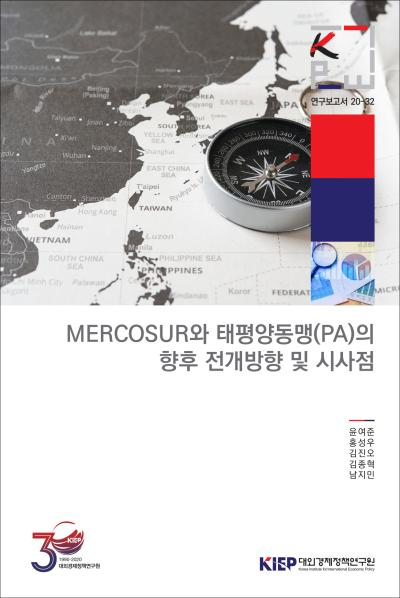Working Papers
PUBLISH
Working Papers
To list

Economic Integration of MERCOSUR and the Pacific Alliance and Its Implications for Korea
Economic opening, Economic integration
Author Yeo Joon Yoon, Sungwoo Hong, Jino Kim, Jonghyuk Kim, and Jimin Nam Series 20-32 Language Korean Date 2020.12.30
MERCOSUR and the Pacific Alliance (PA) are the two major trade blocs in Latin America. Currently, Korea is negotiating a trade agreement (TA) with MERCOSUR and PA. The countries that Korea has signed FTAs in Latin America include Chile, Peru, Colombia and six Central American countries. In other words, Korea has signed free trade agreements with most Latin American countries except Brazil, Mexico, and Argentina. Therefore, to have enhanced access to the Latin American market, Korea-MERCOSUR TA and joining the PA as an associate member is important for Korea.
In this report we study the nature of internal and external integration of MERCOSUR and PA. For better integration of Korea and these Latin American trade blocs in the future, it would be important to understand their current level and nature of integration. The integration in this study has several facets. First, we take a quantitative approach. To do this an integration index is constructed and analyzed. This index considers integration in trade, value chains and so on. The second approach is more qualitative. Specifically the case of the MERCOSUR-EU Trade Agreement and PA associate member negotiation process are investigated. By doing this, we analyze the factors that hinder the external integration of these blocs.
In Chapter 2, we study the integration of MERCOSUR. For MERCOSUR, the ongoing conflict between Brazil and Argentina has been a major obstacle to regional integration. It is no exaggeration to say that the history of MERCOSUR is marked by repetitions of conflict and conflict-resolution between Brazil and Argentina. Some cases were serious enough to threaten the existence of MERCOSUR and most of these conflicts stemmed from economic crises. In the second part of Chapter 2, the negotiation process of the MERCOSUR-EU TA is examined. The MERCOSUR-EU TA took such a long period of time to finalize. It is a typical trade agreement negotiation between advanced and developing regions. At the same time, it is the first trade agreement that MERCOSUR signed with a major economy. Another salient characteristic is that higher standards in environment, labor, intellectual property rights, and digital trade were included at the EU’s request.
Chapter 3 examines the negotiation process between PA and Australia, New Zealand, Canada and Singapore for their associate memberships. At first, it was a multilateral negotiation that involved all the parties. But they realized that it was not easy to reach an agreement with multilateral negotiations. Accordingly, they decided to proceed through bilateral negotiations. In this regard, Singapore and Australia are considering voluntarily excluding sensitive issues in order to advance negotiations. Singapore is considering to exclude IPR and labor rights issues. Australia is considering to withdraw requests for non-discriminatory treatment of digital goods and issues regarding illegal fishing.
In Chapter 4, the determinants of MERCOSUR and PA’s integration and the effect of internal integration on external integration are analyzed. The results can be summarized into three categories. First is the importance of political and institutional variables that have been relatively overlooked in previous analysis. The improvement of the political and institutional environment promotes both internal and external integration in the region. Second, in the case of PA, the promotion of internal integration also enhances external integration, while for MERCOSUR it was estimated that the promotion of internal integration did not lead to promotion of external integration. Third, the improvement of regional integration in terms of the regional value chain leads to an increase in external integration for PA. This implies that the integration of supply chain within PA would eventually lead to increasing integration with non-member countries such as the U.S. and Canada.
Chapter 5 provides implications and discusses Korea’s negotiation strategies with MERCOSUR and PA. With MERCOSUR it is necessary to establish the brand of the trade agreement. For example in the case of the ongoing Canada-MERCOSUR TA negotiations, gender, environment, and labor issues are emphasized and the parties aim for an inclusive trade agreement. With the Korea-MERCOSUR TA, MERCOSUR is very much interested in technical cooperation with Korea. Therefore, these issues need to be branded and emphasized. On the other hand, if the negotiations are prolonged due to the unresolved issues of opening agricultural and industrial product markets, an alternative option would be a ‘Light Trade Agreement’ that excludes sensitive negotiation agenda. Meanwhile it is also necessary to carry out various activities to create a friendly atmosphere in MERCOSUR. It would be ideal to continuously promote the necessity of TA with Korea through joint research and seminars with local economic organizations or think tanks. PA is promoting e-commerce as one of the 23 negotiating agendas. Korea and PA have also confirmed common interest in digital infrastructure and information technology. Accordingly, Korea needs to come up with a strategy to promote cooperation in these areas.
Sales Info
| Quantity/Size | 166 |
|---|---|
| Sale Price | 7 $ |
 공공저작물 자유이용허락 표시기준 (공공누리, KOGL) 제4유형
공공저작물 자유이용허락 표시기준 (공공누리, KOGL) 제4유형
대외경제정책연구원의 본 공공저작물은 "공공누리 제4유형 : 출처표시 + 상업적 금지 + 변경금지” 조건에 따라 이용할 수 있습니다. 저작권정책 참조
